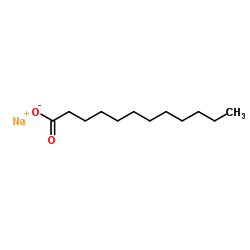Sodium laurate

Sodium laurate structure
|
Common Name | Sodium laurate | ||
|---|---|---|---|---|
| CAS Number | 629-25-4 | Molecular Weight | 222.300 | |
| Density | 1.102 g/cm3 | Boiling Point | 296.1ºC at 760 mmHg | |
| Molecular Formula | C12H23NaO2 | Melting Point | 43.8ºC | |
| MSDS | USA | Flash Point | 134.1ºC | |
| Symbol |


GHS05, GHS07 |
Signal Word | Danger | |
|
Non-animal photosafety screening for complex cosmetic ingredients with photochemical and photobiochemical assessment tools.
Regul Toxicol Pharmacol 72 , 578-85, (2015) Previously, a non-animal screening approach was proposed for evaluating photosafety of cosmetic ingredients by means of in vitro photochemical and photobiochemical assays; however, complex cosmetic ingredients, such as plant extracts and polymers, could not b... |
|
|
Influence of a Neighboring Charged Group on Hydrophobic Hydration Shell Structure.
J. Phys. Chem. B 119 , 9417-22, (2015) Raman multivariate curve resolution (Raman-MCR), as well as quantum and classical calculations, are used to probe water structural changes in the hydration shells of carboxylic acids and tetraalkyl ammonium ions with various aliphatic chain lengths. The resul... |
|
|
Saturated fatty acid composition of human milk in Israel: a comparison between Jewish and Bedouin women.
Isr. Med. Assoc. J. 15(4) , 156-9, (2013) Breast milk is well established as the ideal source of nutrition for infants. Mature human breast milk generally contains 3.5-4.5% lipids comprising mostly triacylglycerols. In general, the fat composition of maternal human milk in developing countries shows ... |
|
|
Color-Controlled Ag Nanoparticles and Nanorods within Confined Mesopores: Microwave-Assisted Rapid Synthesis and Application in Plasmonic Catalysis under Visible-Light Irradiation.
Chemistry 21 , 11885-93, (2015) Color-controlled spherical Ag nanoparticles (NPs) and nanorods, with features that originate from their particle sizes and morphologies, can be synthesized within the mesoporous structure of SBA-15 by the rapid and uniform microwave (MW)-assisted alcohol redu... |
|
|
Protic ionic liquid as additive on lipase immobilization using silica sol-gel.
Enzyme Microb. Technol. 52(3) , 141-50, (2013) Ionic liquids (ILs) have evolved as a new type of non-aqueous solvents for biocatalysis, mainly due to their unique and tunable physical properties. A number of recent review papers have described a variety of enzymatic reactions conducted in IL solutions, on... |
|
|
Prevention of topical surfactant-induced itch-related responses by chlorogenic acid through the inhibition of increased histamine production in the epidermis.
J. Pharmacol. Sci. 121(3) , 242-5, (2013) Effects of chlorogenic acid on surfactant-induced itching were studied in mice. Topical application of sodium laurate increased hind-paw scratching, an itch-related response, 2 h after application, which was inhibited by topical post-treatment with chlorogeni... |
|
|
The role of amphiphilicity and negative charge in glycoprotein 41 interactions in the hydrophobic pocket.
J. Med. Chem. 52 , 4338-44, (2009) The hydrophobic pocket within the coiled coil domain of HIV-1 gp41 is considered to be a hot-spot suitable for small molecule intervention of fusion, although so far it has yielded only microM inhibitors. Previous peptide studies have identified specific hydr... |
|
|
Study of the usefulness of patch testing and use test to predict the safety of commercial topical drugs.
J. Dermatol. 41(6) , 505-13, (2014) Patch testing (PT) can be used to identify allergens and irritants responsible for contact allergic and irritant dermatitis, respectively. However, the reproducibility of PT and correlation between PT and use test has not been fully evaluated. The aim of the ... |
|
|
Topical surfactant-induced pruritus: involvement of histamine released from epidermal keratinocytes.
J. Pharmacol. Exp. Ther. , (2012) Surfactants, an important component of cleansers, often cause itch in humans. Topical application of sodium laurate and N-lauroylsarcosine sodium salt to the skin of mice immediately (for 1-1.5 hours) increased scratching, and the former increased scratching ... |
|
|
Metabolomics reveals amino acids contribute to variation in response to simvastatin treatment.
PLoS ONE 7(7) , e38386, (2012) Statins are widely prescribed for reducing LDL-cholesterol (C) and risk for cardiovascular disease (CVD), but there is considerable variation in therapeutic response. We used a gas chromatography-time-of-flight mass-spectrometry-based metabolomics platform to... |